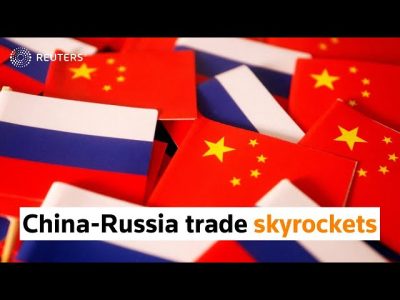Record Growth in Russia-China Trade, Joint Russia-PRC Military Exercise in International Waters: Washington Has “Concerns”

All Global Research articles can be read in 51 languages by activating the Translate Website button below the author’s name.
To receive Global Research’s Daily Newsletter (selected articles), click here.
Click the share button above to email/forward this article to your friends and colleagues. Follow us on Instagram and Twitter and subscribe to our Telegram Channel. Feel free to repost and share widely Global Research articles.
***
The State Department announced on August 15 that the US views the improvement in relations between Beijing and Moscow with “concern.” The announcement was made only days after the US sent warships to monitor Chinese and Russian ships engaged in joint naval exercises in international waters. Nonetheless, the statement is contradictory since the US forced, with their aggressive actions, the tightening of relations between Beijing and Moscow.
State Department spokesperson Vedant Patel addressed a summit between the US, Japan, and South Korea, where the focus is the People’s Republic of China. When asked whether US efforts to “re-establish communication channels with China” could be undermined, Patel said no but expressed concerns about ties between Beijing and Moscow.
“We also have been clear about the continued concern of the PRC and Russia closening their relationship and the steps that they’ve taken as well. So I don’t think these things are zero-sum. We can continue to pursue all of these things appropriately,” he said.
Patel’s remarks come after Washington sent several guided missile destroyers to monitor a group of Russian-Chinese ships that sailed close to the coast of Alaska during a joint military exercise. A US Northern Command spokesperson told CNN that the Russian-Chinese joint naval exercises were a show of force that prompted a US military response but did not pose a threat to the US or Canada.
This did not stop a deluge of claims from the Republicans that US President Joe Biden was failing to deal with the Russia-China alliance. The Republicans unsurprisingly omitted how Washington’s aggressive behaviour first brought the two countries into a close relationship. Russia and China were forced to strengthen their defence and economic ties due to the US emboldening Ukraine to war with Russia and arming and manipulating Taiwan to serve as a pressure point against mainland China.
Trade between Russia and China continues to increase after reaching historic highs in 2022, with imports and exports growing at a double-digit pace since the beginning of this year, according to data released on August 8 by the General Administration of Customs. According to the agency, bilateral trade grew 36.5% between January and July compared to last year, reaching $134.5 billion. During the analysed period, Chinese exports to Russia increased by 73.4% compared to the previous year, reaching $62.5 billion.
Chinese imports from Russia increased by 15.1% to $72 billion. Only in July, the volume of business between the two countries reached $19.4 billion, with Chinese exports of $10.2 billion, slightly surpassing imports from Russia of $9.2 billion. As of the end of 2022, trade between Russia and China grew by 29.3% year-on-year to a record $190.3 billion and is expected to surpass the target of $200 billion soon.
Russian President Vladimir Putin revealed in June at the St. Petersburg International Economic Forum that over 80% of trade settlement between Russia and China is now conducted in Russian rubles and Chinese yuan. His comments came just a month after Russian Deputy Prime Minister Alexander Novak said that energy trading between China and Russia had been settled in their local currencies.
Nonetheless, the dollar is still the most used currency for trade globally, and according to the International Monetary Fund, nearly 60% of international reserves are held in dollar-denominated assets. Western-led sanctions against Russia are making other countries wary of the potential consequences of angering Washington, none more so than China.
Economic ties between Moscow and Beijing have been bolstered by the two countries’ decision to conduct most transactions in national currencies rather than the US dollar to protect themselves from sanctions. Moscow and Beijing were forced to increase efforts to reduce dependence on the dollar and the euro in international trade since Russia is under sanctions and the trade war between the US and China continues.
However, Russia and China cooperate in more than just the economic sphere and the de-dollarisation process. They are also extending their ties in the military sphere.
China’s defence minister Li Shangfu addressed the Moscow Conference on International Security on August 15, his second to Russia since assuming his role as defence chief only earlier this year, thus demonstrating the importance of bilateral ties. He also met with his Russian counterpart Sergei Shoigu to discuss cooperation between the two countries’ militaries, which have been more regularly carrying out joint exercises – including the joint naval patrol off the Alaskan coast previously mentioned.
The fact that the US has “concerns” about improving relations between Beijing and Moscow demonstrates the weak strategic thinking and planning in Washington since their decision to attack these countries simultaneously economically and wage psychological military pressure has resulted in bringing their ties closer.
*
Note to readers: Please click the share button above. Follow us on Instagram and Twitter and subscribe to our Telegram Channel. Feel free to repost and share widely Global Research articles.
Ahmed Adel is a Cairo-based geopolitics and political economy researcher.
Featured image is from InfoBrics

